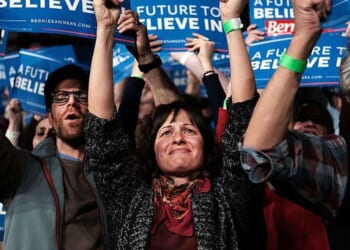In Focus delivers deeper coverage of the political, cultural, and ideological issues shaping America. Published daily by senior writers and experts, these in-depth pieces go beyond the headlines to give readers the full picture. You can find our full list of In Focus pieces here.
Democrats have shut down the government for nearly three weeks, and their one demand is $350 billion to continue temporary COVID-19-era subsidies for health insurance companies and middle- and upper-income Obamacare customers.
The problem Democrats are addressing is a real one: Health insurance plans on the Obamacare marketplace have doubled in price since the law went into effect, and if the 2021 subsidies, misleadingly called “tax credits,” are allowed to expire, many families will see their premiums skyrocket. To be more precise, families will no longer have the taxpayers covering as much of their premiums.
DEMOCRATS HOPE GOP TAKES THE BAIT ON THE NOT-SO-AFFORDABLE CARE ACT
The current problem is a predictable result of Obamacare, a poorly crafted law that increased health spending without improving health.
Obamacare subsidized the purchase of health insurance and healthcare. Using the government to redistribute money toward the health sector was supposed to make people healthier, but it didn’t. It did, however, increase spending in the health sector. Increased demand means higher prices.
Also, the law forced insurers to cover all sorts of expenses for all sorts of people, including all preexisting conditions. The law also restricted how much insurers could charge different rates based on age and health.
This was a big reason that former President Barack Obama’s “if you like your plan, you can keep it” promise was a lie: The law was intended to outlaw plans that supposedly didn’t cover enough. More comprehensive coverage, out of which customers cannot opt, necessarily drives up premiums and healthcare spending overall.
Healthcare spending has increased by more than 35%, adjusted for inflation, since the Obamacare exchanges opened. In the prior decade, healthcare spending increased by about 25%. Put another way, health spending accelerated by 40% after Obamacare went into effect.
Again, this was not an accident. Part of the goal of the bill was to redirect a greater portion of our economy into the health sector. That’s why Obama’s bill had the support of the insurers, the hospitals, the drugmakers, and the doctors.
Take it from the staffers who wrote the bill. David Bowen was the top health staffer on the Senate Health, Education, Labor, and Pensions Committee under Chairman Ted Kennedy (D-MA). There, he was one of the chief authors of the law. After he left Capitol Hill to launch his career as a consultant to healthcare companies, Bowen sat down at a K Street lobbying firm, Sidley Austin, for an event billed as a “unique behind-the-scenes look at the development of this landmark legislation and [an opportunity] to hear an insider’s view about issues that the legislation left unresolved.”
The main “issue that the legislation left unresolved” was controlling healthcare spending. Bowen compared Obamacare to the Massachusetts law, “Romneycare,” that had served as a model for the former.
“In Massachusetts, there was a very conscious decision to do coverage first, knowing that that would bring on a cost battle second,” Bowen explained. “We certainly made the same decision. This is a coverage bill, not a cost reduction bill. There is stuff here that will begin to address the issue of cost, but this is not a cost reduction bill with a bit of coverage on it — it is really trying to get coverage first.”
“Even if the bill did no cost control, it would be an incredible thing for this country,” said Jonathan Gruber, another Obamacare architect. “Politically, it sets the stage for cost control. First … it does comparative effectiveness and pilots and all the rest. But second, once you get coverage off the table, the conversation gets more focused on cost control.”
The conversation never did get more focused on cost control. Democrats never had the appetite for the sort of care rationing and price controls it would take to drive down costs. And so juiced by subsidies, healthcare spending accelerated.
Another part of Obamacare’s design that drove up healthcare spending was the forced consolidation of doctors’ practices and hospitals. Bigger was better, Obamacare’s authors figured.
The law, wrote Obamacare architects Nancy Ann DeParle, Zeke Emanuel, and Robert Kocher, was intended to “unleash forces that favor integration across the continuum of care.” That is, it would force small practices to combine with one another or sell out to hospitals, because “only hospitals or health plans can afford to make the necessary investments in information technology and management skills” under the law.
Consolidation caused higher profits for hospitals, higher prices for patients, and lower quality, according to a 2023 study on the “corporatization of independent hospitals.”
“Those big conglomerates, they just have a lot of clout in the marketplace, more clout than the insurance companies,” one healthcare expert explained to the Boston Globe, “because if [insurers] don’t pay them what they ask for, they’ll drop out of your network.”
This law, which increased spending on healthcare and reduced competition, succeeded in these regards. As a result, health insurance premiums became much more expensive.
From 2014 to 2018, Obamacare’s benchmark premiums rose from $271 per month to $472 per month, a 74% increase.
And expensive premiums lead to even more expensive premiums, thanks to something called adverse selection: If a premium for a young, healthy person climbs to $300 a month, then he might decide health insurance isn’t worth it. That leaves the insurer with a less healthy pool of insureds, which results in higher premiums, driving out even more young, healthy customers. It’s also called a death spiral.
Democrats’ response was to further subsidize health insurance subsidies, temporarily shifting the cost to the taxpayer, while continuing to drive up healthcare spending.
Obamacare subsidized health insurance for lower-income customers buying health insurance through the marketplaces the law created. Anyone who earned less than four times the poverty rate, about $63,000 for an individual or $128,000 for a family of four, can get the subsidy, which covers the entire premium over a certain percentage of their income.
For instance, a man earning $60,000 would face a maximum premium of 9.83% of his income, or $491 a month. This was private health insurance, so the federal government would pay the remainder of the premium to the insurance company.
This subsidy had a failure that is very typical of Democratic safety-net programs for the past 90 years: a cliff.
If that man earning $60,000 hustled and got a side gig for another $200 a month, he would burst past that 4-times-the-poverty-line limit and lose his whole subsidy. His insurance premium might double, and his extra work would actually make him poorer.
During the 2020 election, Democratic presidential nominee Joe Biden proposed a fix: increasing the subsidies for everyone below 400% of the poverty line and extending the subsidies to wealthier customers, so as to get rid of the cliff.
The pandemic provided an excuse for this effort to save Obamacare’s exchanges, and Biden’s American Rescue Plan established these extra subsidies as temporary. But the crisis requiring this fix — the death spirals in the exchange, the general ballooning of healthcare spending — was not temporary. This was always supposed to be a permanent fix to Obama’s leaky 2010 healthcare law.
But when the time came for Democrats to make the extra subsidies permanent, they faced an obstacle: Joe Manchin. The misnamed “Inflation Reduction Act” was the Democrats’ vehicle for extending these subsidies, but the West Virginia senator balked at the price tag. Democrats had to make the bill less expensive to get his vote, so they reduced the 10-year price tag by extending the subsidies only until the end of 2025.
Come 2025, Democrats figured they could use the prospect of skyrocketing middle-class and working-class healthcare premiums as a cudgel with which to attack Republicans.
In this fight, Democrats have had a quiet ally: the health insurance companies.
The extra subsidies are not tax credits to insurance customers, but transfers from the Treasury to private insurance companies. These subsidies have given the insurers more customers, driving up enrollment, and also made customers less price-sensitive because Uncle Sam was picking up part of the tab.
Healthcare scholars Wendy Netter Epstein and Christopher Robertson put it this way: “That means if health insurance companies raise their premiums, those who receive subsidies don’t feel the effect of the premium increases, because the federal subsidy simply grows to cover it. That means companies have fewer reasons to compete on price.”
TWILIGHT OF THE BOOMER PRIESTS
That’s why the insurance industry has launched a lobbying blitz, trying to pressure Republicans to extend these insurance subsidies. Private insurers, together with others in the health sector, are funding a blitz of ads in the districts of Republican members, urging them to extend the Biden tax credits created to save Obama’s insurance markets.
There’s a good chance Republicans will give Democrats and industry what they want, because if anything receives bipartisan support in Washington, it’s bigger government in the service of Big Business.
















